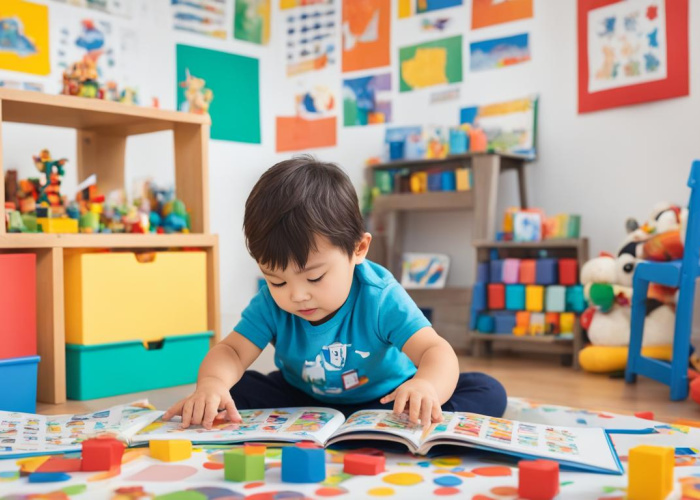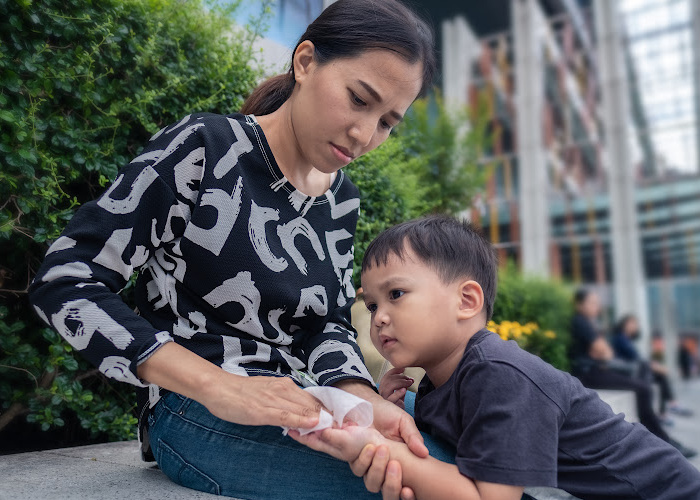It's crucial to know that students with autism and ADHD need special study strategies. Autism…

Signs Your Autistic Child Will Talk: An Ultimate Guide for Parents
Navigating the world of autism can often feel like deciphering a unique language, one where gestures, expressions, and technology play as big a role as words. This guide sheds light on the early signs of communication in autistic children and carves out a roadmap for speech development in autism.
Whether the journey begins with a nonverbal child with autism or with a child who shows early verbal skills, understanding and fostering communication milestones in autistic children is paramount for parents.
Witnessing the signs of speech in autistic children from the use of gestures to the joyful moment when your child echoes your words these are the milestones that signify the beginnings of communication. As we outline these signs and how to encourage them, remember that every child’s path is as individual as they are, and every progress, no matter how small, is a step forward on their communicative journey.
Stay tuned as we delve deep into the indicators and strategies that support your child’s ability to express themselves, ensuring that you’re equipped to assist them at every twist and turn. Let’s embark on this guide through the lens of patience, love, and a dedication to nurturing the voice that’s waiting to be heard.

Understanding Autism Spectrum Disorder and Speech Development
Autism Spectrum Disorder (ASD) encompasses a wide variety of challenges and strengths, particularly when it comes to communication. Understanding the nuances of speech development in autistic children provides invaluable insights into fostering their growth. For parents tracking the early language development in autistic children, recognizing signs your autistic child will talk is pivotal. These signs might include successful attempts at simple phrase speech or instances of echoing, markers of initial strides towards verbal communication.
Impact of ASD on Communication Skills
Children on the autism spectrum often encounter unique challenges in using and interpreting non-verbal cues such as body language and facial expressions. The differences in early language development mean that while one child may show progress in verbal communication for autism, another might communicate more effectively through alternate methods or assistive devices. The varied landscape of communication abilities thus necessitates a tailored approach to speech therapy for autistic children.
Fundamentals of Autism and Language Skills
The development of language skills in autistic children can present in many forms ranging from nonverbal communication to distinct speech patterns like monotonic speech or atypical use of words. For some, certain milestones for autistic children’s speech may be reached atypical times or may unfold non-linearly. Acknowledging and encouraging speech in autistic children, whatever form it may take, remains crucial throughout their developmental stages.
Factors Affecting Speech in Autistic Children
The path to improving verbal communication in autistic children is influenced by an interplay of genetic factors, environmental stimuli, and personal character traits. Each child’s progress is individual, but improvements such as using meaningful two-word phrases or reducing echolalia serve as signs of progress in autistic children’s speech.
Additionally, acknowledging and reinforcing nonverbal gestures or eye contact can signal a deeper comprehension and are steps towards effective communication.
- Monitoring repetitive phrase use as potential signs of progress in verbal communication for autism.
- Looking out for increasing clarity in spoken language and spontaneous use of words.
- Nurturing a communication-friendly environment to further encourage speech in autistic children.
- Considering a range of supportive strategies, including speech therapy for autistic children.

Signs Your Autistic Child Will Talk
When assessing speech development in autistic children, it’s crucial to pay attention to both verbal and nonverbal behaviors. Understanding and recognizing these signs of speech in autistic children can give you insight into their communication progress. Here’s what to look out for as your child grows and develops:
- Echolalia, or the repetition of phrases and words, indicating engagement and the first steps towards speech.
- Attempts to combine words meaningfully, which suggest the emergence of functional language abilities.
- An expanding vocabulary, demonstrating their capacity to absorb and use new words.
- Enhanced sentence structure, a sign they’re beginning to grasp the rules of language.
- Increasingly expressive vocal tones that reflect a broader range of emotions and intents.
Beyond spoken words, be aware of these alternative communication indicators:
- Gestures such as pointing or waving, which may precede or augment speech.
- Facial expressions that convey emotions or responses, adding depth to communication.
- Eye contact which can be fleeting but signifies an attempt to connect and communicate.
These observations can be vital in planning interventions and celebrating the strides your child is making in communicating effectively.

Encouraging Verbal Communication and Alternative Methods
For parents of autistic children, nurturing communication skills is a journey of patience and creativity. The key is to seize every opportunity and adapt strategies that resonate with their unique needs. Here we delve into practical communication tips that combine speech encouragement and acknowledgment of important nonverbal cues, illustrating how embracing a broad spectrum of communicative behaviors can lead to remarkable progress.
How to Encourage Speech in Autistic Children
Communication tips for parents of autistic children often focus on fostering a rich language environment. Start by integrating simple and clear language into everyday interactions – a technique that shines as a beacon to how to encourage speech in autistic children.
Games, songs, and playful exchanges create a fun space for children to voice their thoughts and feelings. Additionally, consider these steps:
- Use visual aids, such as picture cards or social stories, to give context to words and phrases.
- Provide choices during routine activities to inspire your child to use their words.
- Celebrate all forms of attempted communication to boost confidence and participation.
- Tailor activities to your child’s interests to heighten engagement and vocal attempts.
By noting every small step along the communication journey, such as the early signs of communication in autistic children, parents can build upon these interactions in meaningful ways.
Recognizing Nonverbal Communication Milestones
Understanding the full scope of communication extends well beyond spoken language. Communication milestones in autistic children include a variety of nonverbal behaviors that signal their readiness and desire to communicate. Parents are encouraged to pay attention to:
- Gestures and pointing as means of making requests or expressing needs.
- Facial expressions that convey emotions or reactions.
- Responsive body language, such as turning towards someone who’s speaking.
Encouraging signs include the use of alternative communication methods, like sign language, that can serve as a bridge to verbal language. Embracing and nurturing these nonverbal cues are fundamental in improving verbal communication in autistic children.
Speech Therapy and Assistive Technologies
Speech therapy for autistic children is often central to developing both verbal and nonverbal communication skills. Through structured therapy, children can work on articulation, conversation flow, and learning to understand and use language socially. Meanwhile, assistive technologies can offer powerful tools, especially for children with limited or no speech:
- Voice output devices and tablets with speech-generating apps provide a voice for the child to express themselves.
- Multimodal communication apps engage children to practice and learn at their own pace, building confidence in their abilities.
Remember that these resources are not only about replacing speech but also about creating a diversified communication framework for children with diverse needs.
Conclusion
Through the intricate tapestry of development, each autistic child weaves their own narrative in the realm of communication. It’s essential to acknowledge the vast spectrum of milestones for autistic children’s speech each moment, from the slightest gesture to the most elaborate sentence, is a step towards fuller expression. For parents navigating the rich and complex journey of speech development in autistic children, attentiveness to the signs your autistic child will talk is the compass that guides you. Whether it’s a meaningful look, a pointed gesture, or an attempted word, these are the milestones that light the path ahead.
Yet beyond mere observation lies the heart of progress fostering a nurturing environment where verbal and nonverbal communication can blossom. This nurturing comes not only from recognizing the milestones but from consistent and dedicated encouragement of both speech and alternative forms of expression. Professional support services, tailored to augment the developmental needs of each child, serve as the supportive framework upon which families can lean.
Indeed, amidst the nuances of progress and the individualities of each child, patience emerges as a virtue of immeasurable worth. It is with this patience, coupled with understanding and encouragement, that parents can most effectively aid their children. The journey might be long and unique for every family, but guiding each child to find their voice and their unique way to connect requires a connected and informed approach something this guide aims to facilitate in every word and recommendation.
FAQ
What are the early signs of communication in autistic children?
The early signs can include echoing phrases or words (echolalia), using gestures or facial expressions to communicate, initiating any form of communication on their own, and fitting words together in meaningful ways. Progress in nonverbal communication, such as sustained eye contact or pointing, is also noteworthy.
How can speech development in autism differ from non-autistic children?
Speech development in autism can be highly variable. Some children may remain nonverbal, others might have delayed speech onset, and some can develop language skills comparable to their neurotypical peers but have difficulties with the social use of language. Additionally, autistic children might have unique speech patterns, such as unusual tone, pitch, or rhythm.
What role do communication milestones play in assessing an autistic child’s potential for speech?
Communication milestones help to track a child’s progress and guide intervention strategies. While autistic children may reach these milestones on a different timeline, celebrating small victories like using a new word or engaging in interactive play can be significant indicators of potential speech development.
How can parents encourage speech in autistic children?
Parents can encourage speech by interacting with their child through play, reading, and daily routines. Introduce new vocabulary, offer choices to encourage decision-making, use visual supports, and celebrate all attempts at communication, whether verbal or nonverbal. Consistently engaging in activities that promote language skills can be beneficial.
Are there specific strategies to help a nonverbal child with autism communicate?
Yes, strategies include alternative and augmentative communication (AAC) methods like sign language, picture exchange communication systems (PECS), and speech-generating devices or apps. Consistent use of these tools can help a nonverbal child express their needs and thoughts, laying a foundation for potential speech development.
What do signs of progress in verbal communication for autism look like?
Progress can appear as increased use of words, a growing vocabulary, more spontaneous verbal communication, improved clarity in speech, and more frequent interactive communication attempts. Even small advances, like using a new word correctly or engaging in give-and-take exchanges, can signify progress.
When should speech therapy be considered for autistic children?
Speech therapy might be considered if an autistic child shows delays or challenges in communication skills. It can be initiated as soon as concerns arise, often after a diagnosis is made. Early intervention is key, as it can significantly impact language development and communication skills.
How do assistive technologies support communication in children with autism?
Assistive technologies, such as specialized speech-generating applications and devices, offer alternative ways for children with autism to communicate. They can help those who are nonverbal or have limited speech to express themselves, increase their level of interaction, and enhance their learning opportunities.



This Post Has 0 Comments